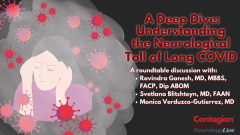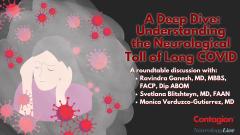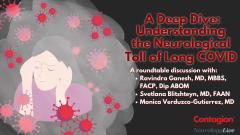
Exploring The Challenges and Insights in Long COVID Treatment and Management
Without a specific tailored Long COVID therapy, individualized treatment based on patient phenotypes, along with extensive evaluations, is essential for effective symptom management.
Episodes in this series
Since the start of the COVID-19 pandemic, the persistence or appearance of neurologic symptoms after clearance of SARS-CoV-2 infection has become a serious health challenge for patients and clinicians worldwide. The effects of post-acute sequelae of SARS-CoV-2 infection (PASC), commonly known as
As emphasized by the research and experts in the field, currently there are no specific tests for the diagnosis of Long COVID, and clinical features such as laboratory findings and biomarkers may not specifically relate to the condition. It is important to develop and validate biomarkers for the prediction, diagnosis, and prognosis of Long COVID and its response to therapeutics. Regardless of age or preexisting health conditions, Long COVID can affect anyone, highlighting that this condition is not restricted to any specific demographic and does not discriminate, even against the healthiest individuals.
In Episode 3 of our Long COVID roundtable collaboration with
Our panel of clinicians includes:
- Ravindra Ganesh, MD, MBBS, FACP, Dip ABOM, general medicine doctor at the Mayo Clinic and leader of their Long COVID clinic.
- Svetlana Blitshteyn, MD, FAAN, clinical associate professor of neurology at the University at Buffalo Jacobs School of Medicine and Biomedical Sciences, director of the Dysautonomia Clinic.
- Monica Verduzco-Gutierrez, MD, physical medicine and rehabilitation physician, professor, and chair of rehabilitation medicine at UT Health, leader of the Long COVID clinic.
Ganesh, Verduzco-Gutierrez, and Blitshteyn emphasized the complexity of the condition, noting the absence of FDA-approved therapies and the importance of individualized care. They highlighted the necessity of tailoring interventions based on patient phenotypes, which can include a range of symptoms and underlying issues. With ongoing research into various treatments and the need for comprehensive education among healthcare providers, they collectively advocated for more therapeutic options and better local care to address the multifaceted challenges faced by Long COVID patients.
Transcript edited for clarity.
Ganesh: Nothing is FDA-approved, and everything we use is pieced together from our understanding of other chronic illnesses. Generally, I tend to phenotype people to see which conditions their Long COVID most closely resembles, and we devise therapeutic interventions based on that. For example, in patients with more of a ME/CFS phenotype, historically, the most helpful treatments have included things like low-dose naltrexone and low-dose Abilify. We've also tried various supplements. Pacing is critical, getting people to avoid overexertion and the subsequent crash. We help people understand how to minimize and mitigate stresses and exposures in their daily lives, like excessive exposure to stimuli can be highly triggering. We also help them with the accommodations they need for work. Often, people either can't work or need a significantly reduced schedule. My patients with orthostatic intolerance may need to sit for most of the day.
For those with a different autonomic phenotype, there are other interventions. I use nerve stimulators for patients with hyperadrenergic dysautonomia post-COVID. We also have medications for Postural Orthostatic Tachycardia Syndrome (POTS), including beta blockers and fludrocortisone, which can be very effective depending on the patient. Then, we have many non-pharmacological interventions. Patients without post-exertional malaise can tolerate some degree of physical activity, especially if it's not vertical. There are activities that can help them regain muscle tone without being too challenging. It's a mixed bag of symptoms and treatments.
In terms of ongoing trials, there are several. The RECOVER trials are looking at treatments like IVIG and Paxlovid. There are also studies on sleep and cognitive dysfunction. Non-RECOVER trials are also of interest, like the REVERSE-Long COVID trial with baricitinib. I'm eager to see the results.
Verduzco-Gutierrez: There isn't a magic cure or pill yet, but figuring out the phenotype is key because symptom management is possible for many patients. For example, so many patients have POTS or some other form of dysautonomia, and there are both pharmacological and non-pharmacological interventions that can help control their symptoms. While it may not eliminate everything, we can manage a lot. There’s sometimes hesitation around starting medications like beta blockers when they’re needed, but I encourage people to try these treatments.
It's also crucial to screen patients for post-exertional malaise because if they have it, we need to identify their energy envelope and ensure they don’t overdo it, which could lead to a crash. Studies show that exercising certain populations can worsen their condition, sometimes causing muscle necrosis. We need to listen carefully to each patient and decide: "Does this person need to pace themselves, or can they increase activity?" It’s essential to tailor an activity modification program based on how the patient responds. Some patients may need to decrease their activity, while others may be able to gradually increase it.
We also see patients with dysfunctional breathing patterns, which are part of the autonomic nervous system. For them, breath work can be very helpful. It helps retrain the diaphragm and allows them to breathe deeply again. Long COVID manifests in many ways, and if a patient has migraines or sleep disorders, we treat those conditions too, sometimes more aggressively than before. Even though there isn’t one medication or treatment that will fix everything, symptom management can still make a big difference.
Blitshteyn: That’s a very thorough and appropriate approach. I do want to caution that I often have patients who come to me from various Long COVID clinics, and the treatment they've been offered is frequently insufficient. Often, they're referred to physical therapy, psychotherapy, or a sleep evaluation, but for many patients, that's not enough. Long COVID is an umbrella term covering multiple phenotypes, so focusing solely on simple interventions isn’t going to work for most patients, many of whom need medications.
We have to learn how to manage these patients, even if we’ve never treated POTS or neuropathic pain before. Education across specialties is going to be critical to improving patient care. While guidelines exist and continue to be published, they won't help if specialists aren't reading them. The old pattern for post-infectious syndromes, checking bloodwork, which usually comes back normal, and then suggesting cognitive behavioral therapy or exercise, won’t cut it for Long COVID. While those treatments are helpful, we need to address the underlying issues like viral persistence, immunologic abnormalities, autoimmunity, and hypercoagulability. You can’t exercise or diet your way out of those.
Ganesh: If you asked me for my wish list for Long COVID patients, besides finding a cure and understanding the pathology, I would wish for better local care. It’s not fair that patients must go to a territory or quaternary care center just to get diagnosed, or try a treatment. When I send them home, it’s often difficult to maintain their care because many physicians won’t continue the treatments. I've heard doctors say, "I’ve never used this, it’s not FDA-approved, and I’m not going to use it off-label." We need better uptake of treatments in primary care across the country.
Verduzco-Gutierrez: I still face resistance from some clinicians who don’t even believe Long COVID is a real disease. Just had a colleague today say one of the patients she saw was told “Long COVID is not real. You're just depressed."
Blitshteyn: Ultimately, we need more therapeutic tools because there won’t be a one-size-fits-all solution. Some patients will respond well to oral medications, others will need infusions, and some may need immunotherapy or antivirals. This is my wish list as well, more options, from over-the-counter remedies to heavy-duty immunotherapies, all FDA-approved and accessible to our patients.
Verduzco-Gutierrez: Exactly, and some patients may have more than one underlying pathophysiology. It’s like a ship with multiple anchors. You might remove one anchor, like autoimmunity, but they could still have others, hypercoagulability or mitochondrial dysfunction. We have to figure out what’s driving each patient’s symptoms and tailor treatments accordingly.
Blitshteyn: We need to study this population to understand the genotypes and phenotypes that predispose them to post-infectious syndromes. For example, we know that joint hypermobility is a predisposing factor. Hopefully, we’ll identify the genes responsible for these post-infectious syndromes that are so disabling.
Stay tuned for future episodes in the coming weeks.
Newsletter
Stay ahead of emerging infectious disease threats with expert insights and breaking research. Subscribe now to get updates delivered straight to your inbox.




















































































































































































































































































